
Medicinal Mushroom Testing
Terpenes, Terpenoids, Beta-Glucan and Heavy Metals Testing for the Betterment of an Industry
At Scout Scientific we are passionate about natural product analysis and have become increasing interested in mushroom testing. Specifically, we are focusing on medicinal mushrooms, commonly referred to as functional mushrooms or functional fungi. These are mushrooms that are used in the form of extracts or powders reported to be for the prevention, alleviation, or healing of multiple diseases, and/or in balancing a healthy diet. We are not mycologists (those that study fungi), nor do we endorse or promote the use of medicinal mushrooms. Instead, we are interested in supporting vendors, and customers by providing sound, scientific information about the composition of mushroom products. The use of these mushrooms is increasing year after year, but the concerns of product quality and safety are lagging and need to be addressed. Scout Scientific can provide solutions to this industry to promote a healthy and safe atmosphere for continuous expansion.
All mushroom testing is performed in a non-GMP, non-ISO laboratory.
Terpenes and Terpenoids, HPLC Testing
Background
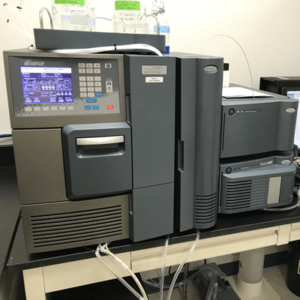 Terpenes and terpenoids are small organic compounds found in medicinal mushrooms. Sometimes they are referred to as diterpenes or triterpenes, which are simply multi-unit terpenes. The key difference between terpenes and terpenoids is that terpenes are common hydrocarbons whereas terpenoids are modified terpenes containing different functional groups and oxidized methyl groups. Typically, these compounds are thought to be the bioactive substances that give each mushroom their specialized health related function. Each medicinal mushroom may contain one or several different terpenes and terpenoids.
Terpenes and terpenoids are small organic compounds found in medicinal mushrooms. Sometimes they are referred to as diterpenes or triterpenes, which are simply multi-unit terpenes. The key difference between terpenes and terpenoids is that terpenes are common hydrocarbons whereas terpenoids are modified terpenes containing different functional groups and oxidized methyl groups. Typically, these compounds are thought to be the bioactive substances that give each mushroom their specialized health related function. Each medicinal mushroom may contain one or several different terpenes and terpenoids.
The best way to determine the content of these compounds is by using an instrument called an HPLC (high pressure liquid chromatography). To be able to calculate the content of these compounds in mushroom products we must compare them to a Reference Standard or Reference Material, which is a purified form of the target compound. To our knowledge there is no other way to determine the amount of terpenes and terpenoids in the mushrooms without a reference standard. Should you see a product label with “high terpene content” or “terpene content”, it may not be correct. Each terpene or terpenoid compound should be specified and their individual amounts listed.
How is Analysis Performed?
There are two ways to perform HPLC analysis of a mushroom product. In one case we can determine the amount of a specific terpene or terpenoid as mentioned above. The other way is to determine if the product (powder, gummy, etc.) contains ANY of the types of terpenes and terpenoids typically found in that exact mushroom. In other words – does the product contain the specified mushroom? This type of untargeted analysis is called Chromatographic Fingerprinting. Just as the name suggests, a chromatographic fingerprint of a client sample is compared to a known source of the target mushroom. This is a qualitative test, not quantitative, thus the amounts cannot be determined but authentication can be assessed by the unique comparison. See the example in the case study below.
Our Solution
We are interested in working with you to perform testing on your mushroom products or provide general mushroom compound research. There are many ways this analysis can be useful, such as determining the amount of a particular terpene, authenticating wholesale products before purchase, or even helping manufacturers optimize their extraction processes. Some medicinal mushrooms have commercially available reference standards for terpene quantification, while others do not. In those cases where the compounds are not available, we may be able to isolate the target terpenes, however that is a time-consuming process and can be expensive. Whatever your needs, we urge you to contact us and let us know how we can help.
Beta-Glucan Testing
Background
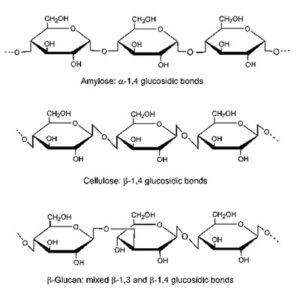 Glucans are polysaccharides derived from glucose monomers. Polysaccharides are carbohydrates (e.g. starch, cellulose, or glycogen) that consist of a number of sugar molecules bonded together. The monomers are linked by glycosidic bonds. Four types of glucose-based polysaccharides are possible: 1,6-(starch), 1,4-(cellulose), 1,3-(laminarin), and 1,2-bonded glucans. Glucans are the most abundant polysaccharides in the cell walls of mushrooms, and their structures are highly variable. Accordingly, their glucose moieties may be joined through either or both alpha (α) or beta (β) linkages, and can be linear, branched, amorphous, or microfibrillar. Beta-Glucans are known for their metabolic and immunomodulatory properties.
Glucans are polysaccharides derived from glucose monomers. Polysaccharides are carbohydrates (e.g. starch, cellulose, or glycogen) that consist of a number of sugar molecules bonded together. The monomers are linked by glycosidic bonds. Four types of glucose-based polysaccharides are possible: 1,6-(starch), 1,4-(cellulose), 1,3-(laminarin), and 1,2-bonded glucans. Glucans are the most abundant polysaccharides in the cell walls of mushrooms, and their structures are highly variable. Accordingly, their glucose moieties may be joined through either or both alpha (α) or beta (β) linkages, and can be linear, branched, amorphous, or microfibrillar. Beta-Glucans are known for their metabolic and immunomodulatory properties.
How is Analysis Performed?
We are using the β-Glucan Assay Kit (Yeast and Mushroom), PN K-YBGL, from Megazyme, which is the current industry standard to measure the Beta-Glucan content in mushroom samples.
Our Solution
We are performing Beta-Glucan analysis using a commerical testing kit. Due to the materials and solutions used during the testing we want to group the samples together for increased efficiency. We will offer discounts for multiple sample submissions. Please contact us for more information.
**Minor Update** We are actively working on methods to determine Beta-Glucan content of tinctures.
Heavy Metals Testing
Background
![]() Mushrooms, like plants, can accumulate toxic heavy metals based on how and where they are grown and/or foraged. If the soil or environment (tree, bark, etc.) is contaminated with heavy metals then the potential is there for the mushroom to contain these toxic materials. These toxins may cause damage to the brain, kidneys, heart, bones, or other organs. In food and dietary supplements, the commonly targeted heavy metals for analysis are Lead (Pb), Mercury (Hg), Arsenic (As), and Cadmium (Cd). As such, we have setup our testing for these four heavy metals.
Mushrooms, like plants, can accumulate toxic heavy metals based on how and where they are grown and/or foraged. If the soil or environment (tree, bark, etc.) is contaminated with heavy metals then the potential is there for the mushroom to contain these toxic materials. These toxins may cause damage to the brain, kidneys, heart, bones, or other organs. In food and dietary supplements, the commonly targeted heavy metals for analysis are Lead (Pb), Mercury (Hg), Arsenic (As), and Cadmium (Cd). As such, we have setup our testing for these four heavy metals.
How is Analysis Performed?
Although we commonly refer to this procedure as “Heavy Metals” testing, its actual name is Elemental Impurities Analysis. In the past, for various products, one would test for total heavy metals content via the monograph in the United States Pharmacopeia (USP). Over ten years ago it was decided that the concentration of elements should be determined individually. Today the method of analysis is performed using Inductively Coupled Plasma-Mass Spectrometry, or ICP-MS, which is an incredibly sensitive instrument. For mushroom powders and extracts, we perform acid digestion of the materials to ensure complete dissolution of all solids. We have partnered with a nearby testing facility to offer this analysis to our customers.
Our Solution
We are performing Heavy Metals testing based on the FDA Elemental Analysis Manual (Section 4.7 ICP-MS Method, Version 1.2, February 2020). Due to the materials, solutions, and reference standards used during the testing we want to group the samples together for increased efficiency. We will offer discounts for multiple sample submissions. Please contact us for more information.
Mushroom Testing Case Study
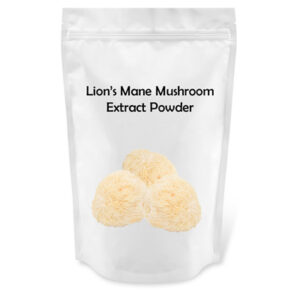 We ordered four Lion’s Mane Extract Powders from Amazon.com to test in our laboratory. We chose vendors that sold several mushroom related products, as well as other types of dietary supplements, demonstrating that they were not small one-product retailers. To protect these companies, their names will not be published here, they have been renamed Lion’s Mane (LM) samples one to four: LM-001, LM-002, LM-003, and LM-004.
We ordered four Lion’s Mane Extract Powders from Amazon.com to test in our laboratory. We chose vendors that sold several mushroom related products, as well as other types of dietary supplements, demonstrating that they were not small one-product retailers. To protect these companies, their names will not be published here, they have been renamed Lion’s Mane (LM) samples one to four: LM-001, LM-002, LM-003, and LM-004.
Our goal was to compare products from different vendors to determine any chemical variance. However, what we discovered was much bigger than a simple evaluation, it was finding that two of the four products we tested were not Lion’s Mane.
Terpene and Terpenoid Testing (HPLC)
First, we obtained Lion’s Mane (Hericium erinaceus) mushroom and performed our own extraction. Our proprietary process was used to extract the bioactive small compounds (terpenes) in the fruiting body. Next, we performed a similar extraction to all four of our extracted powder samples purchased from Amazon. All solutions were then placed on our HPLC instrument and analyzed under optimal conditions.
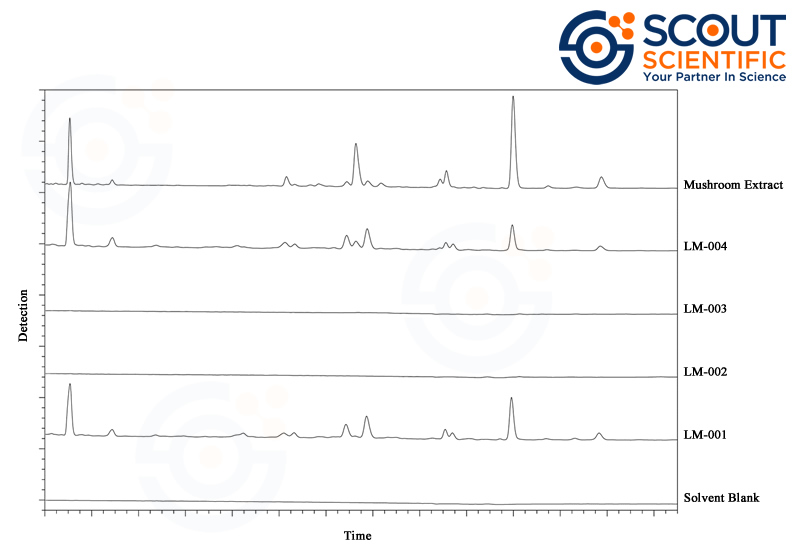
In the above figure we include a blank solvent (with no mushroom sample), the four samples purchased from Amazon and our own extracted mushroom. From this overlay you can see that LM-002 and LM-003 are similar to the solvent blank, exhibiting no peaks (compounds). Samples LM-001 and LM-004 are comparable to the mushroom we extracted. We can qualitatively compare the peaks and their relative intensities (amounts) in the samples to our mushroom extract. Think of this as more of an identification test, determining if the product is real.
We believe this test shows that LM-001 and LM-004 are powders made from Lion’s Mane mushrooms, while products LM-002 and LM-003 do not contain Lion’s Mane. However, let’s compare the Beta-Glucan and Heavy Metals testing for additional confirmation.
Beta-Glucan Testing
The four Amazon samples were tested for their Beta-Glucan content. The samples were prepared for analysis as instructed by the Megazyme test kit. Two of the samples, LM-002 and LM-003, were visually distinct from the other samples during this lengthy testing procedure. The results are in the table below.
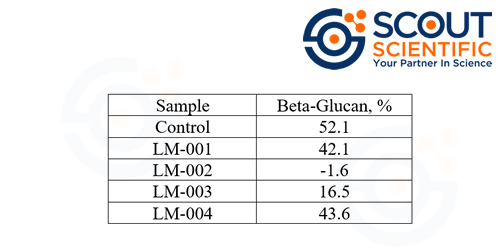
The test kit also includes a Control sample with a known value. The Control is tested with the samples and has a Certificate of Analysis (COA) Beta-Glucan value of 49%. Megazyme’s documentation states that the specification of the Control is +/- 5%, meaning the test itself should give results that are within 5% of the listed value. We meet this specification, giving confidence to our sample results.
Samples LM-001 and LM-004 are once again quite similar, with Beta-Glucan values of 42-43%. These samples are within the expected range of actual Lion’s Mane extracted powders. Samples LM-002 and LM-003 yield some confusing results. LM-003 is only 16.5%, which is much lower than most listed extracted Lion’s Mane powder values that we were able to find online. However, the interesting results is for LM-002 where a negative number is obtained. What is going on?
First, the test for Beta-Glucans is not directly a test for Beta-Glucans. It is a test for Total and Alpha-Glucans content, then the Beta-Glucans is mathematically determined. Total Glucan = Alpha-Glucan + Beta-Glucan. If Beta-Glucan is not in the sample or is at an extremely low level, the calculated value will not be correct. Second, the test kit and its procedures are designed to determine glucan content in mushrooms. If the sample is not from a mushroom, then the results will most certainly vary.
From this data it is shown that LM-001 and LM-004 are both consistent with each other and our expectations as a mushroom extracted powder. Samples LM-002 and LM-003 are once again giving erroneous results, further adding to our questioning their validity.
Heavy Metals Testing
The last test performed on these four Amazon purchased samples of Lion’s Mane Extracted Powders was Heavy Metals. We investigated Lead (Pb), Mercury (Hg), Arsenic (As), and Cadmium (Cd). See the results in the table below.
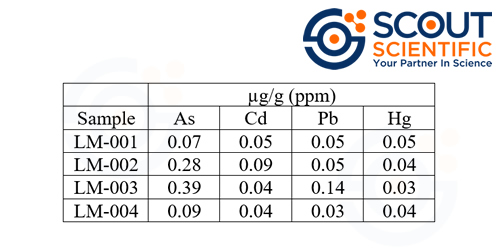
The FDA has not established limits for heavy metals in dietary supplements, so at this time it’s difficult to comment on the levels we see in our samples. It’s at least assuring that samples LM-001 and LM-004 have similar values for the four metals we investigated. Samples LM-002 and LM-003 have slightly higher Arsenic values, but keep in mind these are all very small amounts. The values shown here are the average of duplicate determinations and they should be rounded when reported, but we wanted to show the minor differences.
Conclusion
Scout Scientific set out to demonstrate our ability to analyze mushroom extracts. We ordered Lion’s Mane Extract Powders from four different vendors selling their products on Amazon. We anticipated that we would be looking for minor differences between the vendor samples, but instead found that two of the four samples were not actual Lion’s Mane mushroom powders. They may possibily be mycelium on grain products. The HPLC work clearly shows that not only do samples LM-002 and LM-003 not contain the target compounds, but they also do not contain any detectable (UV active) compounds. Once we reviewed the data we collected, we were curious as to what was in these products. The lack of compounds in the UV spectrum of the chromatogram leads us towards it being a simple grain or starch, but we can only guess as these tests are designed to test for Lion’s Mane compounds.
The FDA does not require specific analytical methods for compliance with cGMPs for dietary supplements, which is how extracted mushrooms are categorized. However, because these products claim to be Lion’s Mane, the FDA would consider these products (LM-002 and LM-003) to be misbranded, thus potentially adulterated.
What about the vendors? Scout Scientific will reach out to all vendors of this case study to let them know what we found. It is our belief that the vendors of LM-002 and LM-003 do not know that they are selling fake products. It does not make it okay, and they are certainly responsible for what they sell, but we feel they may have been misled by those at the wholesale level of the mushroom extract market. If there are any updates to our interactions with these vendors, we will post them to this page.
What’s Next?
There is much more work to be done on not only Lion’s Mane, but other species of medicinal mushrooms. We are currently working on the following projects:
Medicinal Mushrooms in Other Products
Just like some of the currently sought after cannabinoids (CBD, Delta 9, etc.), medicinal mushrooms are increasing in popularity in the functional product marketplace. Lion’s Mane mushroom is now being introduced into gummies, candies, chocolate bars, hot chocolate drinks, coffee, sports drinks, cosmetics, skin care lotions and more as it continues to expand across the industry. However, these vendors may not be receiving an actual mushroom extract to add to their product. Our methods provide vendors with the confidence that their starting material is authentic or that a third-party has formulated their products correctly. Scout Scientific could also confirm that the terpenes are not degraded by the manufacturing process of the target products.
Extraction Optimization
We would like to work with mushroom vendors, including individual foragers, small businesses, and large industries to optimize their extraction processes. We are interested in investigating not only the best methods to perform the extraction, but also the optimal conditions for maximizing specific bioactive compounds. Does a double extraction with hot or cold water make a difference? How about various percentages of ethanol? We can help answer these questions.
Compound Quantitation
A goal of Scout Scientific is to isolate and purify terpene compounds in Lion’s Mane fruiting body. Using LC-MS we believe we have identified most of (if not all) the compounds in our HPLC analysis. We have been working towards the isolation of these compounds. On the small scale we have been very successful, as shown in the following chromatograms. Once we have begun to use more advanced manufacturing techniques it is our hope to be able to provide quantitation of Lion’s Mane Extracts and make these materials commerically available allowing others to do the same in their own laboratories.
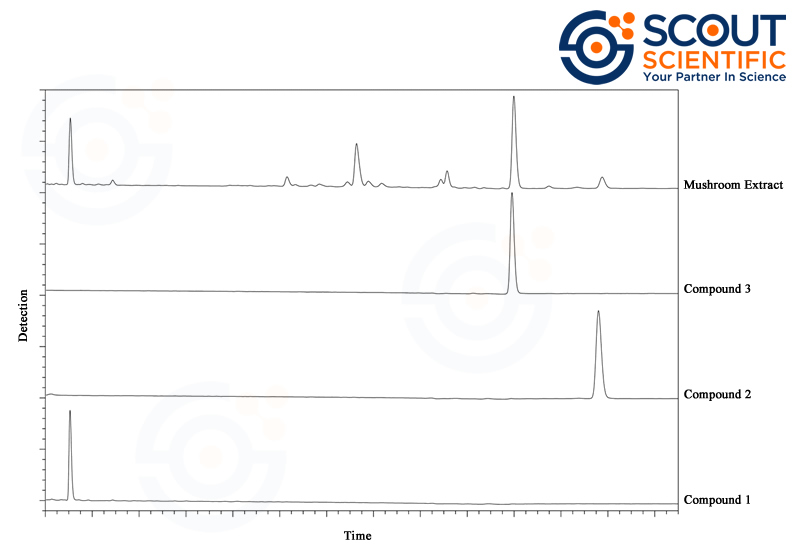
All mushroom testing is performed in a non-GMP, non-ISO laboratory.
